 |
 |
Introduction
Various sorts of charcoal baskets for kamado-style cookers have been available for years now,
with one of the more popular being the Kick Ash Basket. While some of these baskets have been
constructed of sheet metal with holes punched in the sides and bottom, others, like the Kick Ash basket
are constructed of heavy duty stainless steel wire. This wire construction provides for more
air flow through the charcoal. Some folks have questioned whether this open construction and resulting additional
airflow might allow the bottom of the cooker or the firebox to get hotter than they do with the standard cast
iron charcoal grates that you find in many kamado-style cookers. A hotter bottom surface could
conceivably lead to cracking of the shell. It could also possibly cause damage to the surface supporting
the cooker, such as a wood table. Also, they have hypothesized that significantly increased temperatures
might also lead to an increased liklihood of cracking your firebox. Well, hypotheses are fine, but they need
to be backed up with data. So in order to investigate these possibilities, we undertook to measure the
surface temperature on the underside of a cooker and the temperature of the firebox in a medium Big Green Egg
cooker using the original cast iron charcoal grate, a Kick Ash Basket, and a Kick Ash Can.
A medium Big Green Egg cooker was used in these tests. Also used were the original Big Green Egg cast iron charcoal grate, a Kick Ash Basket made for the medium Big Green Egg, and a Kick Ash Can also made for the medium Big Green Egg. (While many of you are familiar with the Kick Ash Basket, perhaps you are wondering about the function of the Kick Ash Can. It is a metal can that is inserted down into the bottom of the firebowl. It collects ash so that when time comes to clean the ash out, all you do is lift the Kick Ash can out of the firebowl and dump the ash.)
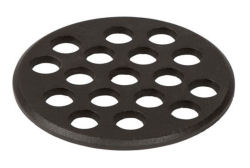 Big Green Egg Charcoal Grate |
 Kick Ash Basket Charcoal Basket |
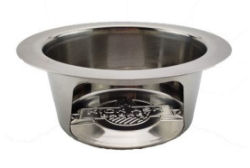 Kick Ash Basket Ash Can |
Cooker Bottom Temperature Methodology
|
The cooker was allowed to heat up to 500°F and stabilize at that temperature for 2 hours. At that point,
temperatures on the bottom surface of the cooker were taken using a Thermoworks Precision Surface Probe (K-type
thermocouple K-030)
at the following nine locations. The probe was held in contact with the bottom surface of the cooker for the
requisite 6 seconds before the reading was recorded.
Note that locations 1, 5, 6, and 9 are outside of the cylinder that forms the bottom of the firebowl. Locations 2, 3, 4, 7, and 8 are located inside the cylinder. Also note that location 5 is just below the bottom vent and the opening into the firebowl. This means that locations 1, 6 and 9 are shielded from the fire by the firebowl cylinder, whereas locations 2, 3, 4, 7 and 8 (and to a lesser extent location 5) are exposed to the fire. |
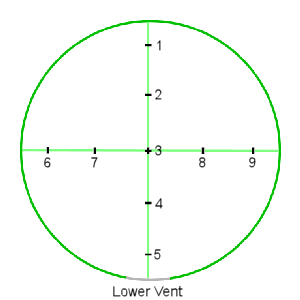
Diagram showing the nine locations |
Cooker Bottom Temperature Observations
Big Green Egg cast iron charcoal grate: The image at right shows the nine locations where the readings were taken using the original Big Green Egg cast iron grate, and the temperature readings at those locations. (All temperatures are in degrees Fahrenheit.)
Kick Ash Basket charcoal basket: The image at right shows the nine locations where the readings were taken using the Kick Ash Basket charcoal basket, and the temperature readings at those locations. (All temperatures are in degrees Fahrenheit.) Also shown in parentheses is the temperature difference between using the BGE grate and the Kick Ash basket at each location. Blue (negative) numbers indicate a lower temperature using the Kick Ash Basket, while red (plus) numbers indicate a higher temperature using the Kick Ash Basket.
As you can see, some locations were slightly hotter, while others were slightly cooler. The net result is that there isn't a significant difference when using the Kick Ash Basket versus the original Big Green Egg charcoal grate.
Kick Ash Basket charcoal basket and Kick Ash Can: The image at right shows the nine locations where the readings were taken using both the Kick Ash Basket charcoal basket and the Kick Ash Can, and the temperature readings at those locations. (All temperatures are in degrees Fahrenheit.) Also shown in parentheses is the temperature difference between using the BGE grate and the Kick Ash Basket/Can combination at each location. Blue (negative) numbers indicate a lower temperature using the Kick Ash Basket and Can, while red (plus) numbers indicate a higher temperature using the Kick Ash Basket and Can.
As you can see, all locations were significantly cooler when the Kick Ash Can is added into the mix. The result is that the bottom surface of the cooker is kept cooler when using the Kick Ash Basket and Can versus the original Big Green Egg charcoal grate.
Temperature Gradient: BGE Grate vs. Kick Ash Basket and Can: One last thing to observe is the difference in temperatures across the bottom of the cooker. The image at right shows temperature difference between the center of the cooker and four outer locations. The temperature differences for the Big Green Egg grate are shown in red, while the temperature differences for the Kick Ash Basket and Can are shown in blue. As you can see, there is a much larger temperature difference using the Big Green Egg charcoal grate than when using the Kick Ash Basket and Can. This smaller temperature difference translates to smaller stresses across the bottom of the cooker.
Firebox Temperature Methodology
|
A stainless steel hose clamp was afixed to the firebox using aluminum wire to hold it in place. The hose clamp was tightened
so as to allow thermocouples to be held in place against the outside wall of the firebox. Four high-temperature
K-type thermocouples (Thermoworks K-38X) were then placed equidistant around the firebox, held in place by the
hose clamp. (The photo at right shows the firebox with thermocouples in place before it was placed into the
medium Big Green Egg cooker.) The thermocouples were monitored using a data recorder, recording readings every 15 seconds.
The cooker was allowed to heat up to 500°F and stabilize at that temperature for 2 hours. Data was recorded
over the entired length of the test, starting with initial lighting of the fire.
The diagram at right shows the approximate locations of the four thermocouples. The view is from the top looking down into the firebox. |
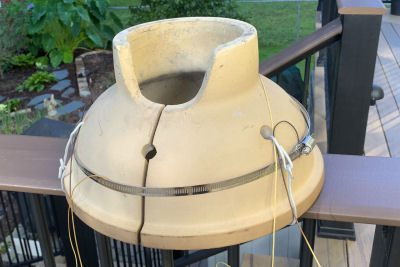 Photo showing thermocouples afixed to the firebox.
Diagram showing approximate location of thermocouples. |
Firebox Temperature Observations
Here are the graphs showing the temperatures over time at the four locations on the firebox for
the three configurations: original BGE grate, Kick Ash Basket only, and Kick Ash Basket with
Kick Ash Can:

| 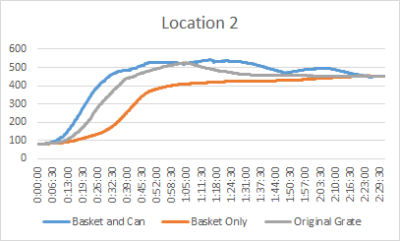
|
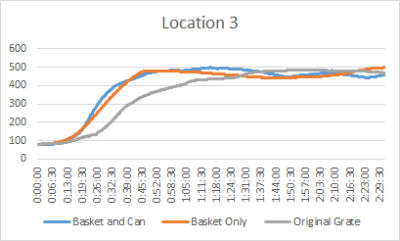
| 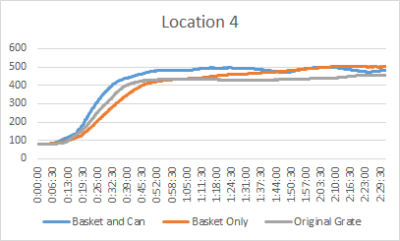
|
And here is a graph of the average of the temperatures from the four locations:

As you can see, the temperature readings from the three configurations eventually come very close to equalizing, showing that no configuration really produced significantly higher temperatures than any other.
Conclusions
The Kick Ash Basket does not result in significantly higher temperatures on the bottom surface
of the cooker than when using the Big Green Egg charcoal grate; in fact, in some locations it is cooler.
We conclude that essentially the two methods of holding the charcoal are roughly equivalent in this regard.
What does make a significant difference is adding a Kick Ash Can to the equation. Using a Kick Ash can resulted in significantly lower temperatures across the bottom surface of the cooker as well as smaller temperature gradients across the bottom surface.
As far as the temperature of the firebox is concerned, the Kick Ash Basket and Kick Ash Can do not cause higher firebox temperatures either.
If you want to use a wire charcoal basket such as the Kick Ash Basket, you need not be concerned that this will expose the bottom of your cooker to higher temperatures. Nor do you need to worry that the basket will damage your firebox due to higher temperatures. Furthermore, if you are concerned about the temperature of the bottom of your cooker and its possible effect on the surface on which the cooker rests, the addition of a Kick Ash Can is a quick and easy way to lower the temperature of the bottom of your cooker.
Availability
Kick Ash Cans and Kick Ash Baskets are available at the Kick Ash web site. If you buy using this link,
we receive a small commission.
Contact Information
Kick Ash Basket
PO Box 854
Neenah, WI. 54957
Phone: (920) 967-3306
Email: info@kickashbasket.com
Web: www.kickashbasket.com
Facebook: www.facebook.com/kickashbasket
You can support this website by shopping at The Naked Whiz Website Store and Amazon.com
|